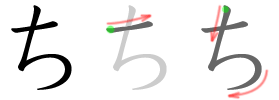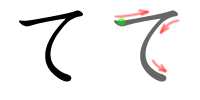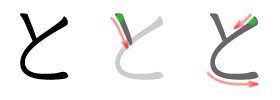The consonant for this column is T, so all five members of this group will be T followed by one of the five vowels, in order.
- た [TA]
- ち [CHI]
- つ [TSU]
- て [TE]
- と [TO]
As with し [SHI] from the last group, there are some slight irregularities in this group in order to make it clearer to English speakers how to pronounce the characters properly. While ち and つ can appear as TI and TU in materials aimed at Japanese readers, typically they are written as shown above so that readers understand that ち should be pronounced CHI (like in “cheese”) and つ should be pronounced as TSU (like in “tsunami”, with a distinct T sound at the beginning).
How to Write
For reference, here is a quick review of the general rules for stroke order:
- All characters should fill a square of about the same size
- Top to bottom, left to right
- Horizontal strokes before vertical strokes that intersect them
Vocabulary Practice
The following words can be written using only the characters we have covered so far. Once you’ve practiced reading them a couple of times, try writing them on a piece of paper without looking and see how well you do.
- たつ [ta tsu] dragon
- てつ [te tsu] iron
- とき [to ki] time
- ち [chi] blood
Sometimes you will see a small tsu つ in the middle of a word (e.g. きって postage stamp). This is known as a sokuon (
- きって [ki t te] postage stamp
- さっき [sa k ki] earlier
Onward!
When you’re ready, click here to move on to Group 5: N!





